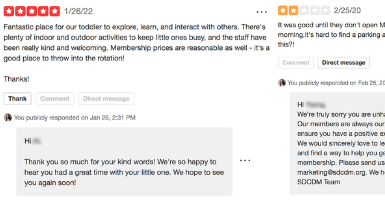June 13, 2022 / News & Blog

| This article is part of the “Communications 2022” issue of Hand to Hand. Click here to read other articles in the issue. |
By Kathleen Sandoval, San Diego Children’s Discovery Museum
Thanks to cell phones and the internet, we are all connected in ways never before experienced. While the opportunities to engage with your favorite musician, actor, or brand are endless, it also means organizations are open to even more criticism through channels like Yelp, Google My Business, TripAdvisor, and more.
According to a Local Consumer Review Survey conducted by Brightlocal, 98 percent of consumers read online reviews for local businesses. This means your guests are researching you before deciding to step foot in your doors, and those reviews can make or break your museum’s image. The customer experience at your institution impacts your overall rating, so when a negative review appears, it’s important to respond. 89 percent of consumers are “highly” or “fairly” likely to use a business that responds to all of its online reviews. Your response could be one of the easiest ways to save your museum’s reputation.
How do marketing and communications professionals respond to the reviews posted about their institutions? From the good, to the bad, to the really bad, we break down the top dos and don’ts when acknowledging and responding to reviews left on public channels.
Whether the review is good or bad, take the time to respond to each and every one. Someone is taking time out of their day to share their experience. A good customer experience means that every customer feels valued and heard.
Now is not the time to get into a debate or endlessly thank your reviewer. Responding is simply an acknowledgment of their kind words or feedback. There are plenty of ways to gather more information, if needed, without writing a novel. Try to keep it to two to three sentences for a positive review. We’ll dive more into negative reviews below.
Someone once gave us a 3-star review because they thought our free, donated coffee was terrible. What?! People will always find reasons to be upset. It isn’t personal. Again, keep it short and sweet when you respond. If the matter is concerning or if you’d simply like to understand the reason for a low-star review, see Rule #4.
Regardless of whether or not a reviewer’s feedback is legitimate, always acknowledge their concerns. The big complainers often just want to vent and have someone listen. You may need more information to determine what happened, so don’t be afraid to ask them to directly message you or email you at a general email like info@[museumname].org.
Just as guests have access to these sites, so do your employees and board members. It’s easy to get heated and want to defend your workplace. However, only a designated representative of the museum should respond to reviews or comments about the museum. It’s all too easy for an employee to misstep and create a mountain out of a molehill. A social media policy will keep employees from speaking on the museum’s behalf.
Whether the reviewer got you mixed up with another museum, or misrepresented or downright lied about their experience, don’t be afraid to report the review. We once had a reviewer complain about our mask policy, but they openly admitted they hadn’t even come inside. Since their review wasn’t based on a legitimate experience at the museum, we reported it, and the review was taken down. Yelp, Google My Business, and many others allow you to report reviews. Assuming your report follows their guidelines, they’ll take it down. If they don’t take it down, refer to Rule #3.
Mistakes happen. Once a reviewer said an employee told them we clean only with essential oils. Yikes. Other reviewers have taken interactions out of context, such as when a guest complained we tried to charge their family of four $40 for an hour (in reality, they had the entire day to enjoy the museum, but chose to leave early). Your employees are the backbone of your organization, so don’t throw them under the bus. Privately talk to your staff about the incident and take the steps necessary to resolve the issue before responding. Once you respond, acknowledge the feedback and briefly mention how you are working to resolve the matter.
Feel free to use these review response templates: positive, top; negative, bottom:
Kathleen Sandoval is the marketing and events manager at the San Diego Children’s Discovery Museum in Escondido, California.